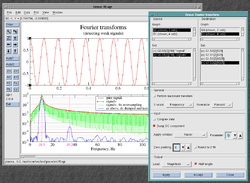Grace (plotting tool)
|
Preview of Grace-6, showing the Fourier transform dialogue | |
| Original author(s) |
Paul Turner (Xmgr) Evgeny Stambulchik (Grace) |
|---|---|
| Developer(s) | Grace Development Team |
| Initial release |
1991 (Xmgr) 1998 (Grace) |
| Stable release |
5.1.25
/ 14 February 2015 |
| Preview release |
5.99.1dev5
/ 7 May 2007 |
| Development status | Active |
| Written in | C |
| Operating system | Any Unix-like |
| Available in | English |
| Type | Plotting |
| License | GPL |
| Website |
plasma-gate |
Grace is a free WYSIWYG 2D graph plotting tool, for Unix-like operating systems. The package name stands for "GRaphing, Advanced Computation and Exploration of data." Grace uses the X Window System and Motif for its GUI. It has been ported to VMS, OS/2, and Windows 9*/NT/2000/XP (on Cygwin). In 1996, Linux Journal described Xmgr (an early name for Grace) as one of the two most prominent graphing packages for Linux.[1]
History
Grace is a descendant of the ACE/gr, also known as Xvgr plotting tool, based on Xview libraries from OpenWindows .[2] Xvgr was originally written by Paul Turner of Portland, Oregon,[3] who continued development until version 4.00.[4] In 1996, development was taken over by the ACE/gr development team, led by Evgeny Stambulchik at the Weizmann Institute of Science, Israel.[5][6] Development of Xmgr was frozen at version 4.1.2 in 1998[3] and the Grace project was started as a fork, released under the GPL.[7] The name stands for "GRaphing, Advanced Computation and Exploration of data" or "Grace Revamps ACE/gr"[6] Turner still maintains a non-public version of Xmgr for internal use.[6] The first version of Grace was numbered 5.0.0 and the latest stable version, 5.1.25 February 2015.[2] Whether the development of the next major release 6.0.0 is still in progress is unclear. The latest preview versions numbered 5.99.* have been released several years ago.[8] It is noteworthy the release in 2011 of QtGrace, developed by Andreas Winter, and GraceGTK, developed by Patrick Vincent. These are two versions of Grace working natively in the Windows operating systems and had releases in 2015.
Features
Grace can be used from a point-and-click interface or scripted (either from the built-in programming language or through a number of language bindings). It performs both linear and nonlinear least-squares fitting to arbitrarily complex user-defined functions, with or without constraints. Other analysis tools include FFT, integration and differentiation, splines, interpolation and smoothing.[9]
Programs using Grace
- GNU Octave can optionally use Grace
- GROMACS
- MOLPRO
- NAMD
- Visual Molecular Dynamics
See also
References
- ↑ Vaught, Andy (1996-08-01), "Graphing with Gnuplot and Xmgr", Linux Journal, retrieved 2009-06-19
- 1 2 Stambulchik, Evgeny (1998–2000), Grace, retrieved 2009-06-20
- 1 2 Stambulchik, Evgeny (1997), Xmgr, retrieved 2009-06-20
- ↑ Paul J Turner and ACE/gr development team (1998-05-13), Xmgr: List of changes, retrieved 2009-06-20
- ↑ ACE/gr development team (1998-05-10), Xmgr user guide: introduction, retrieved 2009-06-20
- 1 2 3 Grace development team (2008-09-20), Grace user guide: "What is Grace?", retrieved 2009-06-20
- ↑ Grace development team (2008-05-21), Grace copyright notice, retrieved 2009-06-20
- ↑ .Grace development team (2006-05-08), Grace-6 Roadmap, retrieved 2009-06-20
- ↑ "Grace at NERSC". NERSC. Retrieved 15 February 2013.
